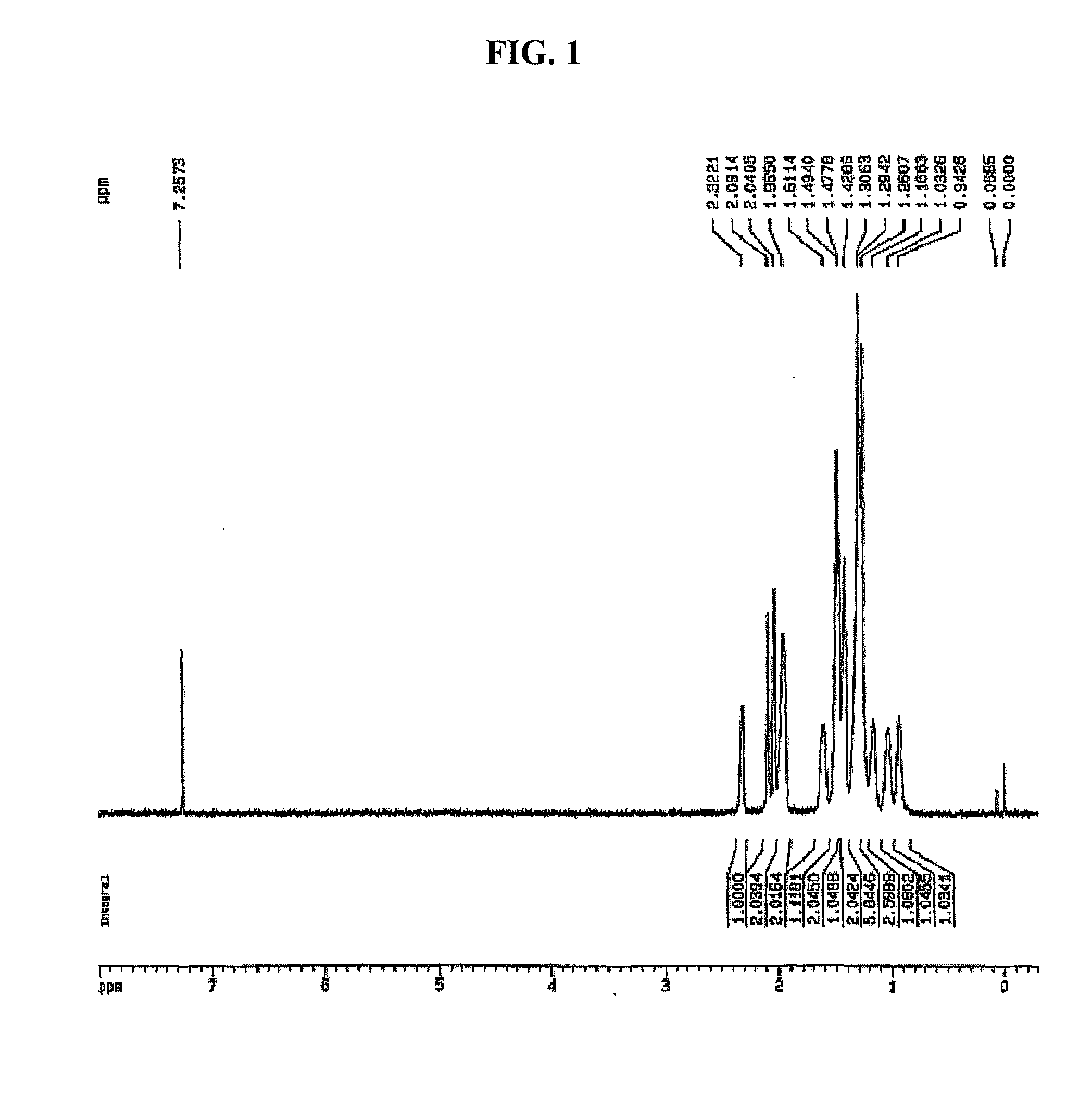Cycloolefin-based polymer compound, preparation method thereof and selective hydrogenation process
- Summary
- Abstract
- Description
- Claims
- Application Information
AI Technical Summary
Benefits of technology
Problems solved by technology
Method used
Image
Examples
examples 1 to 4
5,6-Dihydrodicyclopentadiene-Ethylene Copolymerization
[0131]5,6-dihydrodicyclopentadiene (5.37 g, 40 mmol) and magnetic bars were added into a polymerization reactor in a nitrogen atmosphere, after which toluene was added thereto so as to obtain a total amount of 28 ml. This polymerization reactor was heated to 70° C. with stirring. A compound (0.7 mg, 2 μmol) represented by Formula 6, [Ph3C]+[B(C6F5)4]− (7.4 mg, 8.0 μmol), and triisobutylaluminum (160 mg, 800 μmol) were mixed with 2.0 ml of toluene in a dry box, after which the resulting mixture was added into the reactor using a syringe while being stirred at 70° C., and also ethylene gas was fed therein at a pressure of 60 psig. After 3 min, the ethylene pressure was released, and the reactor was opened and thus the reaction solution was introduced into a vessel containing 30 ml of methanol and thus the reaction product precipitated. Filtration was performed, thus obtaining a precipitate. The precipitate was decompressed to a vac...
example 5
5,6-Dihydrodicyclopentadiene-Norbornene-Ethylene Terpolymerization
[0135]5,6-dihydrodicyclopentadiene (2.7 g, 20 mmol), norbornene (1.9 g, 20 mmol) and magnetic bars were added into a polymerization reactor in a nitrogen atmosphere, after which toluene was added thereto so as to obtain a total amount of 28 ml. This polymerization reactor was heated to 70° C. with stirring. A catalyst (0.7 mg, 2 μmol) represented by Formula 6, [Ph3C]+[B(C6F5)4]− (7.4 mg, 8 μmol), and triisobutylaluminum (160 mg, 800 μmol) were mixed with 2.0 in of toluene in a dry box, after which the resulting mixture was added into the reactor using a syringe while being stirred at 70° C., and also ethylene gas was fed thereto at a pressure of 40 psig. After 7 min, the ethylene pressure was released, and the reactor was opened, and 30 ml of methanol was added and thus the reaction product precipitated. Filtration was performed, thus obtaining a powder. The powder was decompressed to a vacuum at 100° C., so that the ...
example 6
5,6-Dihydrodicyclopentadiene-Cyclopentene-Ethylene Terpolymerization
[0141]5,6-dihydrodicyclopentadiene (2.7 g, 20 mmol), cyclopentene (1.4 g, 20 mmol) and magnetic bars were placed in a polymerization reactor in a nitrogen atmosphere, after which toluene was added thereto so as to obtain a total amount of 28 ml. This polymerization reactor was heated to 70° C. with stirring. A catalyst (0.69 mg, 2 μmol) represented by Formula 6, [Ph3C]+[B(C6F5)4]− (7.4 mg, 8 μmol) and triisobutylaluminum (160 mg, 800 μmol) were mixed with 2.0 ml of toluene in a dry box, after which the resulting mixture was added into the reactor using a syringe while being stirred at 70° C., and also ethylene gas was fed thereto at a pressure of 20 psig. After 6 min 30 sec, the ethylene gas was removed, and the reactor was opened, and thus the reaction was terminated. 30 ml of methanol was added and the reaction solution precipitated. Filtration was performed, thus obtaining powder. The powder was then decompressed...
PUM
| Property | Measurement | Unit |
|---|---|---|
| Temperature | aaaaa | aaaaa |
| Temperature | aaaaa | aaaaa |
| Temperature | aaaaa | aaaaa |
Abstract
Description
Claims
Application Information
 Login to View More
Login to View More - R&D
- Intellectual Property
- Life Sciences
- Materials
- Tech Scout
- Unparalleled Data Quality
- Higher Quality Content
- 60% Fewer Hallucinations
Browse by: Latest US Patents, China's latest patents, Technical Efficacy Thesaurus, Application Domain, Technology Topic, Popular Technical Reports.
© 2025 PatSnap. All rights reserved.Legal|Privacy policy|Modern Slavery Act Transparency Statement|Sitemap|About US| Contact US: help@patsnap.com



